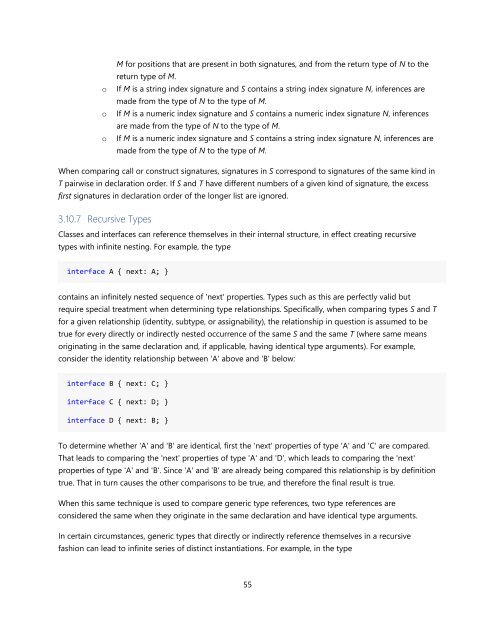TypeScript Language Specification v1.5
TypeScript Language Specification v1.5
TypeScript Language Specification v1.5
Create successful ePaper yourself
Turn your PDF publications into a flip-book with our unique Google optimized e-Paper software.
o<br />
o<br />
o<br />
M for positions that are present in both signatures, and from the return type of N to the<br />
return type of M.<br />
If M is a string index signature and S contains a string index signature N, inferences are<br />
made from the type of N to the type of M.<br />
If M is a numeric index signature and S contains a numeric index signature N, inferences<br />
are made from the type of N to the type of M.<br />
If M is a numeric index signature and S contains a string index signature N, inferences are<br />
made from the type of N to the type of M.<br />
When comparing call or construct signatures, signatures in S correspond to signatures of the same kind in<br />
T pairwise in declaration order. If S and T have different numbers of a given kind of signature, the excess<br />
first signatures in declaration order of the longer list are ignored.<br />
3.10.7 Recursive Types<br />
Classes and interfaces can reference themselves in their internal structure, in effect creating recursive<br />
types with infinite nesting. For example, the type<br />
interface A { next: A; }<br />
contains an infinitely nested sequence of 'next' properties. Types such as this are perfectly valid but<br />
require special treatment when determining type relationships. Specifically, when comparing types S and T<br />
for a given relationship (identity, subtype, or assignability), the relationship in question is assumed to be<br />
true for every directly or indirectly nested occurrence of the same S and the same T (where same means<br />
originating in the same declaration and, if applicable, having identical type arguments). For example,<br />
consider the identity relationship between 'A' above and 'B' below:<br />
interface B { next: C; }<br />
interface C { next: D; }<br />
interface D { next: B; }<br />
To determine whether 'A' and 'B' are identical, first the 'next' properties of type 'A' and 'C' are compared.<br />
That leads to comparing the 'next' properties of type 'A' and 'D', which leads to comparing the 'next'<br />
properties of type 'A' and 'B'. Since 'A' and 'B' are already being compared this relationship is by definition<br />
true. That in turn causes the other comparisons to be true, and therefore the final result is true.<br />
When this same technique is used to compare generic type references, two type references are<br />
considered the same when they originate in the same declaration and have identical type arguments.<br />
In certain circumstances, generic types that directly or indirectly reference themselves in a recursive<br />
fashion can lead to infinite series of distinct instantiations. For example, in the type<br />
55


















